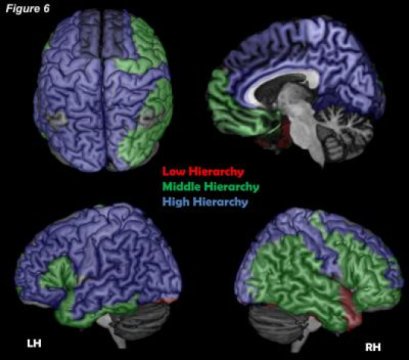At Harvard, they believe that they have found the physical center of human consciousness.

Map of human brain connections
For many hundreds or even thousands of years, people have been trying to understand what consciousness is. Where is the "I" of each person? Representatives of ancient civilizations considered differently. Someone said that “I” is in the stomach, someone else claimed that human consciousness is located in the heart or is in some cosmic sphere at all (not in the current understanding of the cosmos, not at all). A little later, the brain became “suspected” of this. To find out where the human consciousness is still located and to understand what it is, means to understand human nature. What “I” is, the consciousness and personality of each person is still a question. But the areas of the brain that are responsible for ensuring that a person is conscious seem to be found.
“We first discovered the connection between the area of the brain stem that is responsible for wakefulness and the areas that make the thinking process possible. The puzzle elements formed into a single unit, pointing out that this relationship plays a role in human consciousness, ” said Michael Fox of the Beth Israel Deaconess Medical Center at Harvard Medical School.
Researchers have previously demonstrated that brain stem is responsible for wakefulness - a part of the brain that works as a link between the spinal cord and the brain. This area regulates the activity of humans and animals, responsible for sleep and activity, as well as for breathing and heartbeat.
')
As for the thought process, self-awareness, for a long time it was thought that only the cerebral cortex, some part of it or the whole cortex was responsible for this. Harvard scientists have expressed the opinion that two specific parts of the cerebral cortex take part in this process. The system of the brain stem and these two sites, experts say, is the physical center of human consciousness.
In order to make sure of this, the team of scientists studied the histories and conditions of 36 patients with lesions of the brain stem. 12 patients from the examined are in a coma, and 24 - in the mind. Researchers scanned the brain trunks of patients in order to understand which area is damaged in those who are in a coma and which is in those who are conscious.
As it turned out, in 10 of the 12 patients examined who had fallen into a coma, a small area of the brain stem (rostral dorsolateral pontine tegmentum) was damaged. In 24 patients who are conscious, this area is intact. In order to find out what other parts of the brain are connected to it, Harvard scientists have carefully studied the brain map (connection) of a healthy person. As it turned out, two areas of the cerebral cortex are associated with this part of the trunk. We are talking about the islet lobe (islet) and the anterior part of the cingulate gyrus of the cerebral cortex.
Then, the specialists studied images obtained using magnetic resonance imaging (MRI) of the brain of 45 patients in a coma in a vegetative state. This is a condition that is characterized by the lack of an opportunity for spontaneous mental activity (decortication) due to extensive damage or dysfunction of the cerebral hemispheres while preserving the activity of the diencephalic region and brainstem, which preserve the autonomic and motor reflexes. It turned out that in all patients the connection of the indicated portions of the cerebral cortex with the brain stem was disturbed.
The authors of the study understand that the results of their work require repeated verification and call upon independent teams of researchers to study their work in order to verify the validity of the findings or disprove them.
If the conclusions are fair, it will probably help bring patients who are in a vegetative state back to life. “If we are right, maybe one day we will wake up someone who is in a permanent vegetative state now?” This is a very important question, ”says the study leader.

Physicists are trying to build a network of active brain centers, as well as figure out the hierarchy of this network, determining its core.
About a week ago, the work of physicists from Bar-Ilan University in Israel was published on a similar topic. This team decided to use the theory of networks in order to determine the degree of dependence of the human brain to combine data and maintain conscious activity on the structure of the neurons of the cerebral cortex. To do this, scientists have scanned with the help of the same MRI gray areas of the human cortex. White matter was also scanned, but with the help of diffusion spectral tomography.
After that, Israeli physicists decided to use the network analysis technique (k-shell decomposition) to determine what makes consciousness appear. The generally accepted hypothesis of the emergence of consciousness now says that in order for consciousness to appear, the brain must combine various information from different areas of its network. According to Professor Giulio Tononi from the University of Wisconsin, as soon as the amount of information united by the brain exceeds a certain limit, consciousness appears.
Scientists from Israel are planning to study the connections of the whole brain, not just the cortex. This, in their opinion, will make it possible to understand how the joint work of neurons leads to the creation of a network and the emergence of consciousness. Moreover, the answer to this question, experts hope with the help of physics and mathematics.
Source: https://habr.com/ru/post/372853/
All Articles